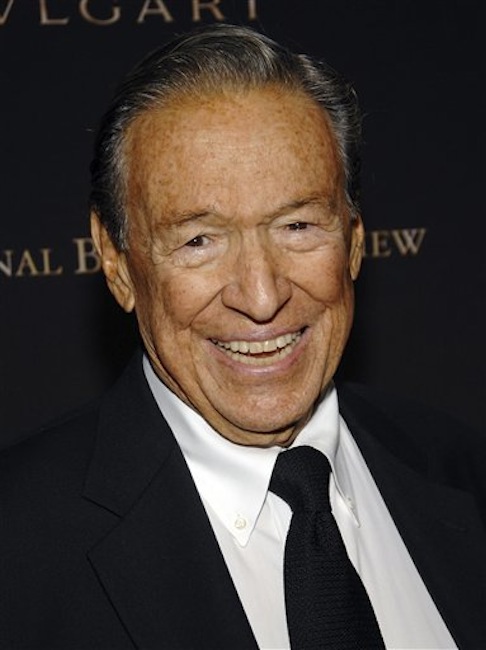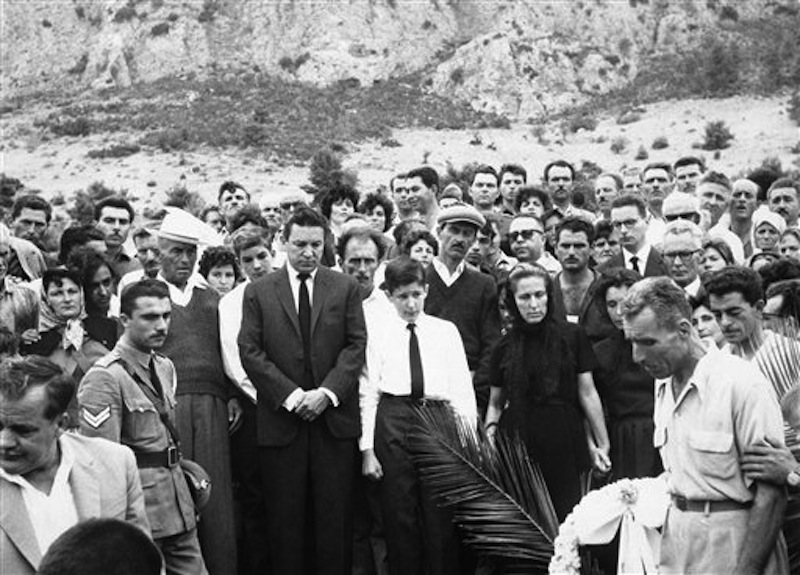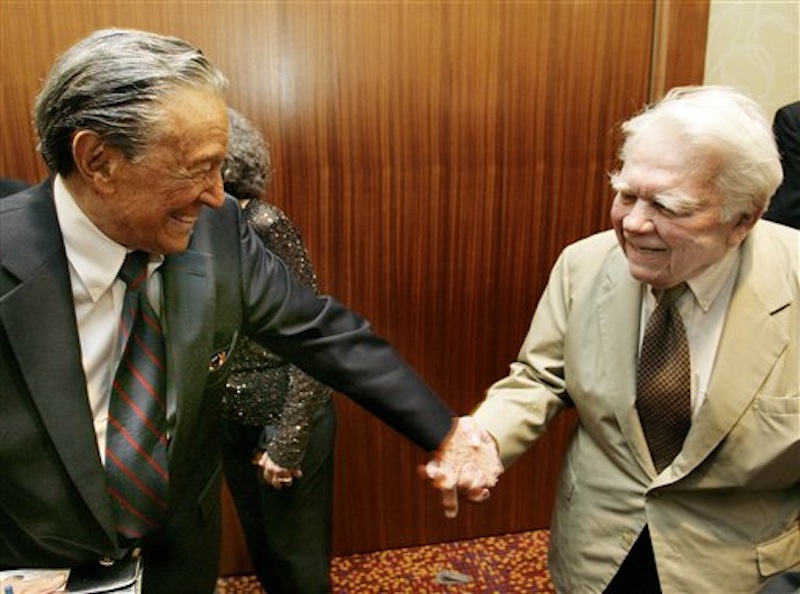NEW YORK — “Mike Wallace is here to see you.”
The “60 Minutes” newsman had such a fearsome reputation that it was often said that those were the most dreaded words in the English language, capable of reducing an interview subject to a shaking, sweating mess.
Wallace, who won his 21st and final Emmy Award at 89, died Saturday in the New Canaan, Conn., care facility where he had lived the last few years of his life. He was 93.
Wallace didn’t just interview people. He interrogated them. He cross-examined them. Sometimes he eviscerated them pitilessly. His weapons were many: thorough research, a cocked eyebrow, a skeptical “Come on” and a question so direct it took your breath away.
He was well aware that his reputation arrived at an interview before he did, said Jeff Fager, CBS News chairman and Wallace’s long-time producer at “60 Minutes.”
“He loved it,” Fager said Sunday. “He loved that part of Mike Wallace. He loved being Mike Wallace. He loved the fact that if he showed up for an interview, it made people nervous. … He knew, and he knew that everybody else knew, that he was going to get to the truth. And that’s what motivated him.”
Wallace made “60 Minutes” compulsively watchable, television’s first newsmagazine that became appointment viewing on Sunday nights. His last interview, in January 2008, was with Roger Clemens on his alleged steroid use. Slowed by a triple bypass later that month and the ravages of time on a once-sharp mind, he retired from public life.
During the Iranian hostage crisis in 1979, he asked Iran’s Ayatollah Khomeini — then a feared figure — what he thought about being called “a lunatic” by Egyptian President Anwar Sadat. Khomeini answered by predicting Sadat’s assassination.
Late in his career, he interviewed Russian President Vladimir Putin, and challenged him: “This isn’t a real democracy, come on!” Putin’s aides tried to halt the interview; Putin said he was the president, he’ll decide what to do.
“Many people who weathered a Mike Wallace interview grew to respect him greatly and, you know, have great regard for him because I don’t recall anybody ever saying to me, ‘He took a cheap shot’ or ‘He did the obvious,’ or that he was, you know, playing some kind of game,” Fox News Channel Chairman Roger Ailes said on Sunday. “He actually was trying to serve the audience, and that’s what made him great.”
When a Wallace story found little to back up rumors that Coors beer executives were racist, the relieved company took out newspaper ads trumpeting that it had survived. The ad’s top: “The four most dreaded words in the English language: Mike Wallace is here.”
He was equally tough on public and private behavior. In 1973, with the Watergate scandal growing, he sat with top Nixon aide John Ehrlichman and read a long list of alleged crimes, from money laundering to obstructing justice. “All of this,” Wallace noted, “by the law-and-order administration of Richard Nixon.”
The surly Ehrlichman could only respond: “Is there a question in there somewhere?”
In the early 1990s, Wallace reduced Barbra Streisand to tears as he scolded her for being “totally self-absorbed” when she was young and mocked her decades of psychoanalysis. “What is it she is trying to find out that takes 20 years?” Wallace wondered.
“I’m a slow learner,” Streisand told him.
“He was hands down the best television interviewer ever,” said Steve Kroft, his former “60 Minutes” colleague. “I can’t think of anyone, besides (CBS legend Edward R.) Murrow, who had a greater influence in shaping television journalism.”
“60 Minutes” pioneered the use of “ambush interviews,” with reporter and camera crew corralling alleged wrongdoers in parking lots, hallways, wherever a comment — or at least a stricken expression — might be harvested from someone dodging reporters’ phone calls. Wallace once went after a medical laboratory offering Medicaid kickbacks to doctors in this fashion.
They were phased out after founding executive producer Don Hewitt termed them “showbiz baloney.” ”Finally I said, ‘Hey, kid, maybe it’s time to retire that trenchcoat,'” Hewitt recalled.
Wallace’s late colleague Harry Reasoner once said, “There is one thing that Mike can do better than anybody else: With an angelic smile, he can ask a question that would get anyone else smashed in the face.”
As a young producer at the CBS’ New York affiliate, Fager first dealt with Wallace when he had to cut down one of the reporter’s story to 90 seconds for a broadcast.
“I was scared of him and intimidated by him,” he said. “He knew it and he would just make you more miserable. That was Mike. He always had a twinkle in his eye, and even if you were intimidated by him, it was hard not to love him.”
His prosecutorial style was admired, imitated, condemned and lampooned. In a 1984 skit on “Saturday Night Live,” Harry Shearer impersonated Wallace, and Martin Short played weaselly, chain-smoking attorney Nathan Thurm, who becomes comically evasive, shifty-eyed and nervous under questioning.
Wallace was the first man hired when Hewitt put together the staff of “60 Minutes” at its inception in 1968. The show wasn’t a hit at first, but worked its way up to the top 10 in the 1977-78 season and remained there year after year. Among other things, it proved there could be big profits in TV journalism. It remains the most popular newsmagazine on TV.
Wallace said he didn’t think he had an unfair advantage over his interview subjects: “The person I’m interviewing has not been subpoenaed. He’s in charge of himself, and he lives with his subject matter every day. All I’m armed with is research.”
Wallace himself became a dramatic character in several projects, from the stage version of “Frost/Nixon,” when he was played by Stephen Rowe, to the 1999 film “The Insider,” based in part on a 1995 “60 Minutes” story about tobacco industry whistle-blower Jeffrey Wigand, who accused Brown & Williamson of intentionally adding nicotine to cigarettes. Christopher Plummer starred as Wallace and Russell Crowe as Wigand. Wallace was unhappy with the film, in which he was portrayed as caving to pressure to kill a story about Wigand.
Operating on a tip, The New York Times reported that “60 Minutes” planned to excise Wigand’s interview from its tobacco expose. Wigand had signed a nondisclosure agreement with his former company, and the network feared that by airing what he had to say, “60 Minutes” could be sued along with him.
The day the Times article appeared, Wallace downplayed the gutted “60 Minutes” story as “a momentary setback.” He soon sharpened his tone. When the revised report finally aired, he told viewers that he was “dismayed that the management at CBS had seen fit to give in to perceived threats of legal action.” The full report eventually was broadcast.
In addition to his Emmys, Wallace won five DuPont-Columbia journalism and five Peabody awards.
In all, his television career spanned six decades, much of it at CBS. In 1949, he appeared as Myron Wallace in a show called “Majority Rules.” In the early 1950s, he was an announcer and game show host for programs such as “What’s in a Word?” He also found time to act in a 1954 Broadway play, “Reclining Figure,” directed by Abe Burrows.
In the mid-1950s came his smoke-wreathed “Night Beat,” a series of one-on-one interviews with everyone from an elderly Frank Lloyd Wright to a young Henry Kissinger that began on local TV in New York and then appeared on the ABC network. It was the show that first brought Wallace fame as a hard-boiled interviewer, a “Mike Malice” who rarely cut his subjects any slack.
Wrote Coronet magazine in 1957: “Wallace’s interrogation had the intensity of a third degree, often the candor of a psychoanalytic session. Nothing like it had ever been known on TV. … To Wallace, no guest is sacred, and he frankly dotes on controversy.”
Consider this “Night Beat” exchange, with colorful restaurateur Toots Shor. Wallace: “Toots, why do people call you a slob?” Shor: “Me? Jiminy crickets, they musta’ been talking about Jackie Gleason.”
In those days, Wallace said, “interviews by and large were virtual minuets. … Nobody dogged, nobody pushed.” He said that was why “Night Beat” ”got attention that hadn’t been given to interview broadcasts before.”
It was also around then that Wallace did a bit as a TV newsman in the 1957 Hollywood drama “A Face in the Crowd,” which starred Andy Griffith as a small-town Southerner who becomes a political phenomenon through his folksy television appearances. Two years later, Wallace helped create “The Hate That Hate Produced,” a highly charged program about the Nation of Islam that helped make a national celebrity out of Malcolm X and was later criticized as biased and inflammatory.
After holding a variety of other news and entertainment jobs, including serving as advertising pitchman for a cigarette brand, Wallace became a full-time newsman for CBS in 1963.
He said it was the death of his 19-year-old son Peter in an accident in 1962 that made him decide to stick to serious journalism from then on. (Another son, Chris, followed his father and became a broadcast journalist. He anchors “Fox News Sunday” on Fox broadcast.)
Wallace had a short stint reporting from Vietnam and took a sock in the jaw while covering the tumultuous 1968 Democratic convention in Chicago. But he didn’t fit the stereotype of the Eastern liberal journalist. He was a close friend of the Reagans and was once offered the job of Richard Nixon’s press secretary. He called his politics moderate.
One “Night Beat” interview resulted in a libel suit, filed by a police official angry over remarks about him by mobster Mickey Cohen. Wallace said ABC settled for $44,000, and he called it the only time money had been paid to a plaintiff in a suit in which he was involved.
The most publicized lawsuit against him was by retired Gen. William C. Westmoreland, who sought $120 million for a 1982 “CBS Reports” documentary, “The Uncounted Enemy: A Vietnam Deception,” that accused Westmoreland and others of deliberately underestimating enemy troop strength during the Vietnam War.
Westmoreland dropped the libel suit in 1985 after a long trial. Lawyers for each side later said legal costs of the suit totaled $12 million, of which $9 million was paid by CBS.
Wallace said the case brought on depression that put him in the hospital for more than a week. “Imagine sitting day after day in the courtroom, hearing yourself called every vile name imaginable,” he said.
In 1996, he appeared before the Senate’s Special Committee on Aging to urge more federal funds for depression research, saying that he had felt “lower, lower, lower than a snake’s belly” but had recovered through psychiatry and antidepressants. He later disclosed that he once tried to commit suicide during that dark period. Wallace, columnist Art Buchwald and author William Styron were friends who commiserated often enough about depression to call themselves “The Blues Brothers,” according to a 2011 memoir by Styron’s daughter, Alexandra.
Wallace called his 1984 book, written with Gary Paul Gates, “Close Encounters.” He described it as “one mostly lucky man’s encounters with growing up professionally.” In 2005, he brought out his memoir, “Between You and Me.”
Wallace was born Myron Wallace on May 9, 1918, in Brookline, Mass. He began his news career in Chicago in the 1940s, first as a radio news writer for the Chicago Sun and then as a reporter for WMAQ. He started at CBS in 1951.
He was married four times. In 1986, he wed Mary Yates Wallace, the widow of his close friend and colleague Ted Yates, who had died in 1967. Besides his wife, Wallace is survived by his son, a stepdaughter, Pauline Dora, and stepson Eames Yates.
Send questions/comments to the editors.






